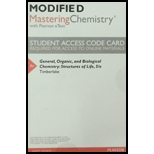
(a)
Interpretation:
The condensed structural formula for the product of reaction between terephthalic acid and ethylene glycol in the 1:1 ratio needs to be determined.
Concept Introduction:
(b)
Interpretation:
The condensed structural formula for the product of reaction between the product in part (a) and 1 mol of ethylene glycol needs to be determined.
Concept Introduction:
Polymers are formed by polymerisation of certain monomer units. Based on type of chemical reaction, polymerisation can be two types; condensation polymerisation and addition polymerisation. Addition polymerisation occurs between unsaturated monomer units whereas condensation polymerisation occurs with elimination of water molecule as by-product between two functional groups. PETE is an example of condensation polymer.
(c)
Interpretation:
The mass of PETE recycled in one year needs to be determined.
Concept Introduction:
Polymers are formed by polymerisation of certain monomer units. On the basis of type of chemical reaction, polymerisation can be two types; condensation polymerisation and addition polymerisation. Addition polymerisation occurs between unsaturated monomer units whereas condensation polymerisation occurs with elimination of water molecule as by-product between two functional groups. PETE is an example of condensation polymer.
(d)
Interpretation:
The volume of PETE recycled in 1 year needs to be determined.
Concept Introduction:
Polymers are formed by polymerisation of certain monomer units. On the basis of type of chemical reaction, polymerisation can be two types; condensation polymerisation and addition polymerisation. Addition polymerisation occurs between unsaturated monomer units whereas condensation polymerisation occurs with elimination of water molecule as by-product between two functional groups. PETE is an example of condensation polymer.
(e)
Interpretation:
The number of landfills required to fill the amount of PETE recycled in 1 year needs to be determined.
Concept Introduction:
Polymers are formed by polymerisation of certain monomer units. On the basis of type of chemical reaction, polymerisation can be two types; condensation polymerisation and addition polymerisation. Addition polymerisation occurs between unsaturated monomer units whereas condensation polymerisation occurs with elimination of water molecule as by-product between two functional groups. PETE is an example of condensation polymer.
Want to see the full answer?
Check out a sample textbook solution
Chapter 18 Solutions
Modified MasteringChemistry with Pearson eText - Valuepack Access Card - for General, Organic, and Biological Chemistry: Structures of Life
 ChemistryChemistryISBN:9781305957404Author:Steven S. Zumdahl, Susan A. Zumdahl, Donald J. DeCostePublisher:Cengage Learning
ChemistryChemistryISBN:9781305957404Author:Steven S. Zumdahl, Susan A. Zumdahl, Donald J. DeCostePublisher:Cengage Learning ChemistryChemistryISBN:9781259911156Author:Raymond Chang Dr., Jason Overby ProfessorPublisher:McGraw-Hill Education
ChemistryChemistryISBN:9781259911156Author:Raymond Chang Dr., Jason Overby ProfessorPublisher:McGraw-Hill Education Principles of Instrumental AnalysisChemistryISBN:9781305577213Author:Douglas A. Skoog, F. James Holler, Stanley R. CrouchPublisher:Cengage Learning
Principles of Instrumental AnalysisChemistryISBN:9781305577213Author:Douglas A. Skoog, F. James Holler, Stanley R. CrouchPublisher:Cengage Learning Organic ChemistryChemistryISBN:9780078021558Author:Janice Gorzynski Smith Dr.Publisher:McGraw-Hill Education
Organic ChemistryChemistryISBN:9780078021558Author:Janice Gorzynski Smith Dr.Publisher:McGraw-Hill Education Chemistry: Principles and ReactionsChemistryISBN:9781305079373Author:William L. Masterton, Cecile N. HurleyPublisher:Cengage Learning
Chemistry: Principles and ReactionsChemistryISBN:9781305079373Author:William L. Masterton, Cecile N. HurleyPublisher:Cengage Learning Elementary Principles of Chemical Processes, Bind...ChemistryISBN:9781118431221Author:Richard M. Felder, Ronald W. Rousseau, Lisa G. BullardPublisher:WILEY
Elementary Principles of Chemical Processes, Bind...ChemistryISBN:9781118431221Author:Richard M. Felder, Ronald W. Rousseau, Lisa G. BullardPublisher:WILEY





